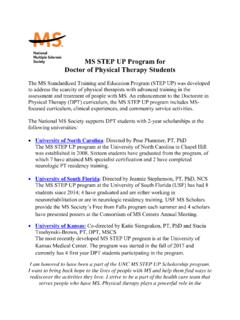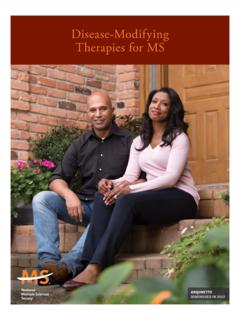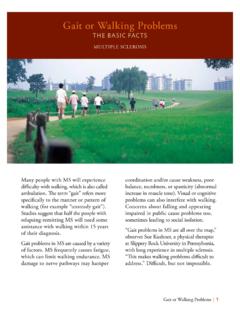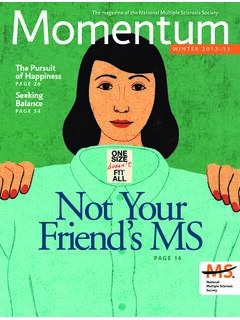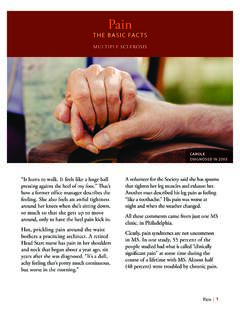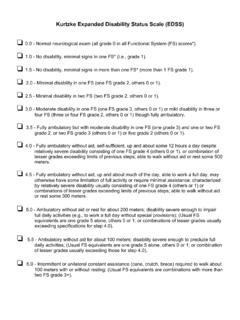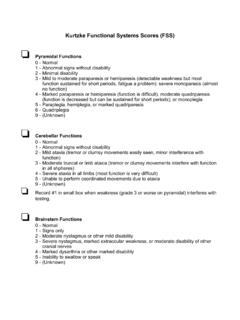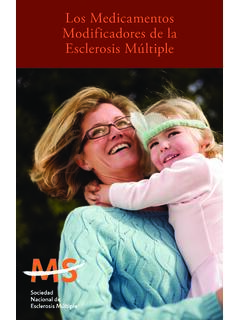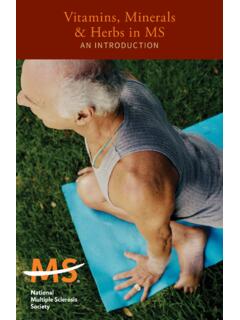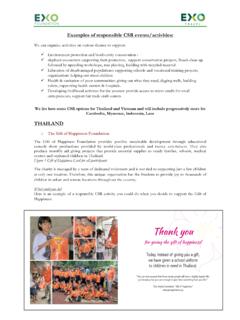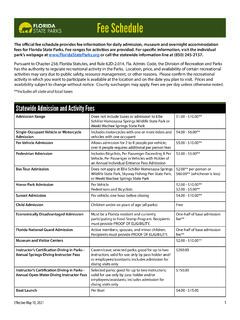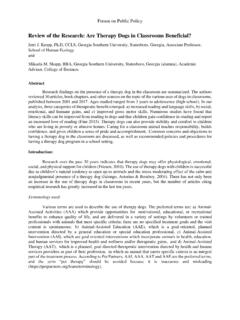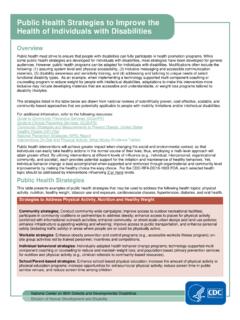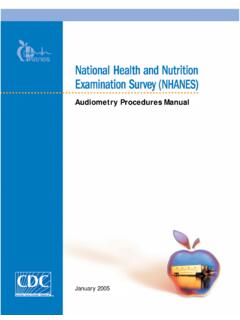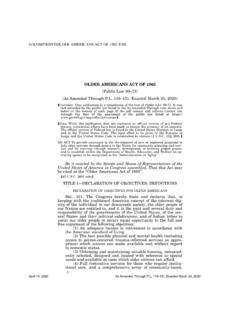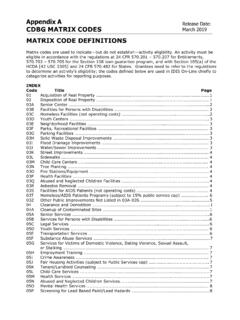Transcription of MATERIALS FOR AQUATIC EXERCISE INSTRUCTORS
1 AQUATIC EXERCISE Programming for people with Multiple SclerosisMATERIALS FOR AQUATIC EXERCISE INSTRUCTORSE dited by Deborah P. Hertz, MPH, National Director, Medical programs Clinical Programs Department National MS Society, New York, NY. : Helen Tilden, RN, National MS Society, Georgia Chapter Clinical Advisory Committee and National MS Society, Special Project ConsultantMiranda Mirsec MA, CES, National MS Society Southern California Chapter Programs Manager, Physical Health and RecreationBrian Hutchinson, MS PT, President, Heuga Center and National MS Society Clinical ConsultantDecember 2003 The Professional Resource CenterThe Professional Resource Center (PRC)
2 Of the Clinical Programs Department supports the work of health professionals by providing a range of library and literature search services, as well as information and consultation about the disease and its management, insurance and long-term care issues, and the Society s professional education more information: Toll-free number: 1-866-MS-TREAT (1-866-678-7328) Email: Professional website: manual has developed over time thanks to the efforts of many Society chapter staff and Divine, TRS, Patricia Finlay, McSP/PT and Helen Tilden, RN, of the Georgia Chapter, developed an aquatics manual in 1993 that was subsequently adopted as a national vision for the new format came from Denise Nowak, RD (certified by the American Council on EXERCISE ) and Miranda Mirsec, MA, CES of the Southern California special thanks is also due to Amy Brown (Mid South Chapter ), Suzanne Carrone (Gateway Area Chapter), Connie Nesbary (Michigan Chapter)
3 , and Jo-Ellen Zembruski (New York City Chapter) for their Hutchinson, MS, PT, National MS Society Clinical Consultant and Nancy Holland, EdD, RN, MSCN, Vice President, Clinical Programs Department reviewed this cover photo: Robert, diagnosed in 1990 2016 National Multiple Sclerosis Programming for people with MS ..2 Why Water Works?!? ..2 AQUATIC Programs for people with MS ..2 Benefits and Considerations of an AQUATIC Program ..2 Focus on Function ..3 Strategies for Adapting Movement ..3 Using the Physical Properties of Water ..3 Considering Functional Levels.
4 4 Body Mechanics ..4 Impact Options for AQUATIC EXERCISE ..5 Use of Equipment ..6 General EXERCISE Principles ..8 Exercises for people with MS ..8 Marching/Alternating Knee Lifts ..9 Side Steps ..10 Static Hamstring Stretch ..10 Active Chest Stretch ..11 Trunk Twists Spinal Rotation ..11 Leg/Hamstring Curl ..11 Walking ..11 Pelvic Tilts ..12 Cross Country Ski ..12 Rocking Horse ..12 Straight Leg Walk ..13 Side Tilt/Lateral Weight Shift ..14 Additional EXERCISE Options ..15 Class Structure and Cueing ..20 Lesson Planning ..23 Cueing ..24 Music ..24 Pool Safety and the Environment.
5 24A National Multiple Sclerosis Society AQUATIC Program ..26 Objectives ..26 National MS SocietyAquatic EXERCISE Programming for people with MS | 2 WHY WATER WORKS?!?Water is a very inviting EXERCISE environment for many people with MS. Cool water temperatures 80-84 degrees Fahrenheit helps to keep core body temperatures low, reducing the chances of overheating. As mentioned in Intro to MS for Fitness and Wellness Professionals, overheating can cause temporary worsening of MS natural properties of water including buoyancy or weightlessness combined with resistance create an excellent environment for movement and EXERCISE .
6 Participants can learn to use the properties of water to best meet their specific EXERCISE /fitness needs. Likewise EXERCISE in a pool offers stability and support to practice functional activities such as ambulation. Water often provides support many people with MS need to stand and maintain balance for exercises that would otherwise be too difficult on PROGRAMS FOR people with MSThe purpose of an AQUATIC recreational program is socialization and EXERCISE , and is intended to meet goals such as increased function and sense of well-being. The AQUATIC class is not intended to be a hands on treatment or therapy.
7 A recreational program is designed to offer people with MS with varying levels of disability or activity limitations an opportunity to participate, including individuals who use assistive devices. The class is taught in shallow water in a group setting with an emphasis on fun and independence. Benefits will vary from individual to AQUATIC program can include aerobic EXERCISE , strengthening, balance training, and stretching in addition to a warm-up and cool-down. Recreation is diversion, rest, relaxation, entertainment, EXERCISE , play and hopefully, enjoyable. The AQUATIC program for people with MS provides an opportunity to maintain mobility, prevent secondary symptoms of MS, maintain or improve flexibility, maximize muscle strength, and maintain or increase endurance recommended pool temperature for an aquatics program for people with MS is 80 84 AND CONSIDERATIONS OF AN AQUATIC PROGRAMFrom Report of the Surgeon General, United States Department of Health and Human Services, (1996)
8 , people with disabilities are less likely to engage in regular moderate activity than people without disabilities , yet they have similar needs to promote their health and prevent unnecessary disease. The report also recommends community based programs to meet the needs of persons with disabilities . A community based AQUATIC EXERCISE program is an excellent way to add activity, strengthen the cardiovascular system, reduce body fat, and decrease offers benefits such as: Less energy expenditure required for movements Increased muscle strength due to use of water resistance Opportunity to practice balance and coordination ( with more ease than on land) Relaxing effects of buoyancy on the skeletal structure and increased ease of walking in water due to buoyancy Protection from falls ( soft landing)
9 Opportunity to weight bear on the lower extremities Increased circulation A cool EXERCISE environment which can increase endurance with activityAquatic Programming for people with MSNational MS SocietyAquatic EXERCISE Programming for people with MS | 3 Possible considerations may include: Loss of balance due to upward thrust of buoyancy, use of foam equipment or deep water. Fatigue and muscle weakness if water temperature is too warm Effects of incontinence Skin breakdown Decreased opportunity for full weight bearing Fear of waterFOCUS ON FUNCTIONIn general, most movement is beneficial for individuals living with MS.
10 As you focus on developing programs for people with MS, consider movements that address functional factors include: Weakness Spasticity/Spasms Lack of coordination Balance difficulties Tremors Fatigue PainA focus on function in the pool means choosing exercises/activities with the goal of improving coordination, flexibility, balance, muscle strength, endurance, and possibly cardiovascular fitness. Exercises in these areas can improve functional mobility such as transfers, gait and stair climbing. Most importantly, the activities need to be for Adapting MovementComponents of EXERCISE design to be considered when developing a multiple sclerosis AQUATIC class include.

